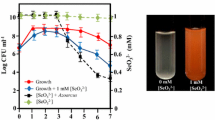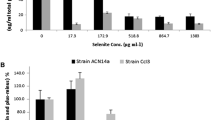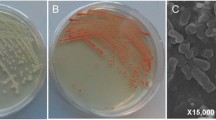Abstract
The ability to reduce selenite (SeO3 2−) ions with the formation of selenium nanoparticles was demonstrated in Azospirillum brasilense for the first time. The influence of selenite ions on the growth of A. brasilense Sp7 and Sp245, two widely studied wild-type strains, was investigated. Growth of cultures on both liquid and solid (2 % agar) media in the presence of SeO3 2− was found to be accompanied by the appearance of the typical red colouration. By means of transmission electron microscopy (TEM), electron energy loss spectroscopy (EELS) and X-ray fluorescence analysis (XFA), intracellular accumulation of elementary selenium in the form of nanoparticles (50 to 400 nm in diameter) was demonstrated for both strains. The proposed mechanism of selenite-to-selenium (0) reduction could involve SeO3 2− in the denitrification process, which has been well studied in azospirilla, rather than a selenite detoxification strategy. The results obtained point to the possibility of using Azospirillum strains as endophytic or rhizospheric bacteria to assist phytoremediation of, and cereal cultivation on, selenium-contaminated soils. The ability of A. brasilense to synthesise selenium nanoparticles may be of interest to nanobiotechnology for “green synthesis” of bioavailable amorphous red selenium nanostructures.




Similar content being viewed by others
References
Avazeri C, Turner RJ, Pommier J, Weiner JH, Giordano G, Vermeglio A (1997) Tellurite and selenate reductase activity of nitrate reductases from Escherichia coli: correlation with tellurite resistance. Microbiology 143:1181–1189
Basaglia M, Toffanin A, Baldan E, Bottegal M, Shapleigh JP, Casella S (2007) Selenite-reducing capacity of the copper-containing nitrite reductase of Rhizobium sullae. FEMS Microbiol Lett 269(1):124–130
Bashan Y, de-Bashan LE (2010) How the plant growth-promoting bacterium Azospirillum promotes plant growth—a critical assessment. Adv Agron 107:77–136
Bashan Y, Holguin G, de-Bashan LE (2004) Azospirillum-plant relationships: physiological, molecular, agricultural, and environmental advances (1997–2003). Can J Microbiol 50(8):521–577
Belimov AA, Dietz K (2000) Effect of associative bacteria on element composition of barley seedlings grown in solution culture at toxic cadmium concentrations. Microbiol Res 155(2):113–121
Buchs B, Evangelou MW, Winkel LH, Lenz M (2013) Colloidal properties of nanoparticular biogenic selenium govern environmental fate and bioremediation effectiveness. Environ Sci Technol 47(5):2401–2407
Day JM, Döbereiner J (1976) Physiological aspects of N2-fixation by a Spirillum from Digitaria roots. Soil Biol Biochem 8:45–50
de-Bashan LE, Hernandez JP, Morey T, Bashan Y (2004) Microalgae growth-promoting bacteria as “helpers” for microalgae: a novel approach for removing ammonium and phosphorus from municipal wastewater. Water Res 38(2):466–474
DeMoll-Decker H, Macy JM (1993) The periplasmic nitrite reductase of Thauera selenatis may catalyze the reduction of selenite to elemental selenium. Arch Microbiol 160(3):241–247. doi:10.1007/BF00249131
de Souza MP, Huang CPA, Chee N, Terry N (2009) Rhizosphere bacteria enhance the accumulation of selenium and mercury in wetland plants. Planta 209:259–263
Doran JW (1982) Microorganisms and the biological cycling of selenium. In: Marshall KC (ed) Advances in microbial ecology. Plenum, New York, pp 1–32. http://link.springer.com/chapter/10.1007/978-1-4615-8318-9_1
Dungan RS, Yates SR, Frankenberger WT (2003) Transformations of selenate and selenite by Stenotrophomonas maltophilia isolated from a seleniferous agricultural drainage pond sediment. Environ Microbiol 5(4):287–295
Fibach-Paldi S, Burdman S, Okon Y (2012) Key physiological properties contributing to rhizosphere adaptation and plant growth promotion abilities of Azospirillum brasilense. FEMS Microbiol Lett 326(2):99–108
Gadd GM (2010) Metals, minerals and microbes: geomicrobiology and bioremediation. Microbiology 156(3):609–643
Gao X (2012) Selenium nanoparticles with improved biological effects. US Patent Application 13/206,542 (filed Aug. 10, 2011). Publ. no. 2012/0202062 A1 (publ. date: August 9, 2012). http://www.faqs.org/patents/app/20120202062
Garbisu C, Ishii T, Leighton T, Buchanan BB (1996) Bacterial reduction of selenite to elemental selenium. Chem Geol 132(1):199–204
Hockin S, Gadd GM (2006) Removal of selenate from sulfate-containing media by sulfate-reducing bacterial biofilms. Environ Microbiol 5:816–826
Hu CH, Li YL, Xiong L, Zhang HM, Song J, Xia MS (2012) Comparative effects of nano elemental selenium and sodium selenite on selenium retention in broiler chickens. Anim Feed Sci Technol 177:204–210
Huang XD, El-Alawi Y, Penrose DM, Glick BR, Greenberg BM (2004) A multi-process phytoremediation system for removal of polycyclic aromatic hydrocarbons from contaminated soils. Environ Pollut 130(3):465–476
Huber R, Sacher M, Vollmann A, Huber H, Rose D (2000) Respiration of arsenate and selenate by hyperthermophilic archaea. Syst Appl Microbiol 23(3):305–314
Hunter WJ, Kuykendall LD (2007) Reduction of selenite to elemental red selenium by Rhizobium sp. strain B1. Curr Microbiol 55(4):344–349
Hunter WJ, Manter DK (2009) Reduction of selenite to elemental red selenium by Pseudomonas sp. strain CA5. Curr Microbiol 58:493–498
Ikram M, Faisal M (2010) Comparative assessment of selenite (SeIV) detoxification to elemental selenium (Se0) by Bacillus sp. Biotechnol Lett 32:1255–1259
Kamnev AA, Renou-Gonnord M-F, Antonyuk LP, Colina M, Chernyshev AV, Frolov I, Ignatov VV (1997) Spectroscopic characterization of the uptake of essential and xenobiotic metal cations in cells of the soil bacterium Azospirillum brasilense. Biochem Mol Biol Int 41(1):123–130
Kamnev AA, Tugarova AV, Antonyuk LP, Tarantilis PA, Kulikov LA, Perfiliev YuD, Polissiou MG, Gardiner PHE (2006) Instrumental analysis of bacterial cells using vibrational and emission Mössbauer spectroscopic techniques. Anal Chim Acta 573–574:445–452
Kamnev AA, Sadovnikova JN, Tarantilis PA, Polissiou MG, Antonyuk LP (2008) Responses of Azospirillum brasilense to nitrogen deficiency and to wheat lectin: a diffuse reflectance infrared Fourier transform (DRIFT) spectroscopic study. Microb Ecol 56:615–624
Kamnev AA, Tugarova AV, Tarantilis PA, Gardiner PHE, Polissiou MG (2012) Comparing poly-3-hydroxybutyrate accumulation in Azospirillum brasilense strains Sp7 and Sp245: the effects of copper(II). Appl Soil Ecol 61:213–216
Kessi J, Hanselmann KW (2004) Similarities between the abiotic reduction of selenite with glutathione and the dissimilatory reaction mediated by Rhodospirillum rubrum and Escherichia coli. J Biol Chem 279(49):50662–50669
Kessi J, Ramuz M, Wehrli E, Spycher M, Bachofen R (1999) Reduction of selenite and detoxification of elemental selenium by the phototrophic bacterium Rhodospirillum rubrum. Appl Environ Microbiol 65:4734–4740
Kramer GF, Ames BN (1988) Mechanisms of mutagenicity and toxicity of sodium selenite (Na2SeO3) in Salmonella typhimurium. Mutat Res Fundam Mol Mechan Mutagen 201(1):169–180. doi:10.1016/0027-5107(88)90123-6
Kuzmin PG, Shafeev GA, Voronov VV, Raspopov RV, Arianova EA, Trushina EN, Gmoshinskii IV, Khotimchenko SA (2012) Bioavailable nanoparticles obtained in laser ablation of a selenium target in water. Quant Electron 42(11):1042–1044. doi:10.1070/QE2012v042n11ABEH014754
Lenz M, Lens PNL (2009) The essential toxin: the changing perception of selenium in environmental sciences. Sci Total Environ 407(12):3620–3633
Losi ME, Frankenberger WT Jr (1997) Reduction of selenium oxyanions by Enterobacter cloacae SLD1a-1: isolation and growth of the bacterium and its expulsion of selenium particles. Appl Environ Microbiol 63(8):3079–3084
Lucy M, Reed E, Glick BR (2004) Applications of free living plant growth-promoting rhizobacteria. Antonie Van Leeuwenhoek 86(1):1–25
Mennini T (2012) Elemental selenium nanoparticles with reduced toxicity. Nutrafoods 11: N25-N26. http://www.nutrafoods.eu/pubs/pdf/Nanotech-2012(2).pdf
Mulyukin AL, Suzina NE, Pogorelova AYu, Antonyuk LP, Duda VI, El’-Registan GI (2009) Diverse morphological types of dormant cells and conditions for their formation in Azospirillum brasilense. Microbiology (Moscow) 78:33–41
Narayanan KB, Sakthivel N (2010) Biological synthesis of metal nanoparticles by microbes. Adv Colloid Interf Sci 156:1–13
Peng D, Zhang J, Liu Q, Taylor EW (2007) Size effect of elemental selenium nanoparticles (nano-Se) at supranutritional levels on selenium accumulation and glutathione S-transferase activity. J Inorg Biochem 101:1457–1463
Pogorelova AYu, Mulyukin AL, Antonyuk LP, Galchenko VF, El’-Registan GI (2009) Phenotypic variability in Azospirillum brasilense strains Sp7 and Sp245: association with dormancy and characteristics of the variants. Microbiology (Moscow) 78(5):559–568
Rauschenbach I, Yee N, Häggblom MM, Bini E (2011) Energy metabolism and multiple respiratory pathways revealed by genome sequencing of Desulfurispirillum indicum strain S5. Environ Microbiol 13(6):1611–1621
Riedel GF, Sanders JG, Gilmour CC (1996) Uptake, transformation, and impact of selenium in freshwater phytoplankton and bacterioplankton communities. Aquat Microb Ecol 11(1):43–51
Roux M, Sarret G, Pignot-Paintrand I, Fontecave M, Coves J (2001) Mobilization of selenite by Ralstonia metallidurans CH34. Appl Environ Microbiol 67(2):769–773
Sabaty M, Avazeri C, Pignol D, Vermeglio A (2001) Characterization of the reduction of selenate and tellurite by nitrate reductases. Appl Environ Microbiol 67(11):5122–5126
Sarret G, Avoscan L, Carrière M, Collins R, Geoffroy N, Carrot F, Covès J, Gouget B (2005) Chemical forms of selenium in the metal-resistant bacterium Ralstonia metallidurans CH34 exposed to selenite and selenate. Appl Environ Microbiol 71(5):2331–2337
Schloter M, Hartmann A (1998) Endophytic and surface colonization of wheat roots (Triticum aestivum) by different Azospirillum brasilense strains studied with strain-specific monoclonal antibodies. Symbiosis 25:159–179
Shi L, Xun W, Yue W, Zhang C, Ren Y, Shi L, Wang Q, Yang R, Lei F (2011) Effect of sodium selenite, Se-yeast and nano-elemental selenium on growth performance, Se concentration and antioxidant status in growing male goats. Small Rumin Res 96(1):49–52
Simon L, Biró B, Balázsy S, Győri Z (2008) Rhizosphere processes in the selenium accumulation of fodder radish. Sereal Res Commun 36(Suppl):1811–1814. http://www.akademiai.com/content/074301116x42787w/?p=f0fbc94f56e940ceb997872545ea741b&pi=2
Stolz JF, Basu P, Santini JM, Oremland RS (2006) Arsenic and selenium in microbial metabolism. Annu Rev Microbiol 60:107–130
Stolz JF, Oremland RS (1999) Bacterial respiration of selenium and arsenic. FEMS Microbiol Rev 23:615–627
Tugarova AV, Burov AM, Burashnikova MM, Kamnev AA (2014) Gold(III) reduction by the rhizobacterium Azospirillum brasilense with the formation of gold nanoparticles. Microb Ecol 67(1):155–160. doi:10.1007/s00248-013-0329-6
Weiss KF, Ayres JC, Kraft AA (1965) Inhibitory action of selenite on Escherichia coli, Proteus vulgaris, and Salmonella thompson. J Bacteriol 90(4):857–862
Williams KH, Wilkins MJ, N’Guessan AL, Arey B, Dodova E, Dohnalkova A, Holmes D, Lovley DR, Long PE (2013) Field evidence of selenium bioreduction in a uranium‐contaminated aquifer. Environ Microbiol Rep 5(3):444–452. doi:10.1111/1758-2229.12032
Acknowledgements
The authors are grateful to Dr. A.G. Shchelochkov and V.F. Kurskii (Saratov, Russia) for their help in carrying out the X-ray fluorescence analyses. This work was supported in part under the Agreement on Scientific Cooperation between the Russian and Hungarian Academies of Sciences for 2011–2013 (Project 29).
Conflict of Interest
The authors declare that they have no conflict of interest.
Author information
Authors and Affiliations
Corresponding authors
Rights and permissions
About this article
Cite this article
Tugarova, A.V., Vetchinkina, E.P., Loshchinina, E.A. et al. Reduction of Selenite by Azospirillum brasilense with the Formation of Selenium Nanoparticles. Microb Ecol 68, 495–503 (2014). https://doi.org/10.1007/s00248-014-0429-y
Received:
Accepted:
Published:
Issue Date:
DOI: https://doi.org/10.1007/s00248-014-0429-y




